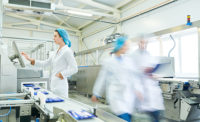Nanotechnology deals with “nanoscale” materials and structures, their synthesis and applications.
The tremendous advantages of nanotechnology stem directly from the unique characteristics exhibited by myriad materials when reduced to the nanoscale compared to their macroscopic counterparts. Some of the advantages include increased surface area-to-volume ratio and quantum effects that begin to dominate the behavior of matter. These factors can change and/or enhance material properties such as strength, reactivity, and electrical and optical characteristics, etc.
|
Learn more at Process Expo Readers can visit www.myprocessexpo.com to register for Process Expo, Nov. 3-6, 2013, at McCormick Place in Chicago, and to find out more about the educational program the trade show has to offer in 2013. |
The growth of nanotechnology is very brisk worldwide. It is estimated that by the year 2015, the global impact of nanotechnology in various products will reach $1 trillion US per year. Compared to such industries as health care and electronics, the applications of nanotechnology in the food industry are rather limited, relatively speaking, but they are showing significant growth. Many new nanotechnological advances are beginning to impact the food industry in aspects ranging from food safety to molecular synthesis of new food products and delivery of bioactive ingredients.
Although nanotechnology is potentially useful in all areas of food production and processing, many nanotechnology applications are either too expensive or too impractical for the food industry. For this reason, nanoscale techniques are perhaps most cost-effective in the following areas of the food industry:
- Food formulations
- Development and delivery of new functional materials
- Biosensing for detecting pathogens, toxins, allergens and other deleterious food constituents
- Active and biodegradable food packaging
Biosensing
Biosensors are analytical devices incorporating a biological material (e.g., tissue, microorganisms, organelles, cell receptors, enzymes, antibodies, nucleic acids, natural products, etc.), a biologically derived material (e.g., recombinant antibodies, engineered proteins, aptamers, etc.) or a biomimic (e.g., synthetic catalysts, combinatorial ligands and imprinted polymers) intimately associated with or integrated within a physicochemical transducer or transducing microsystem, which may be optical, electrochemical, thermometric, piezoelectric, magnetic or micromechanical.
Four major elements of biosensors are:
- Analyte (or sample), which is the system being sensed
- Biointerface, which directly interfaces with the analyte and forms an analyte-bioelement complex. (Bioreceptors that are popularly used include nucleic acids, antibodies, enzymes and cells, etc.)
- Electrical interface, which translates the analyte-bioelement complex formation event into a corresponding electrical signal (normally achieved using nanostructures, electrodes etc.), and
- Electronic interface, which is a system of electronic components that is used to amplify, filter and display the biosensor output in a form suitable for the end-user.
Biosensing remains one of the major growth opportunities for nanotechnologies. In the food industry, biosensor development is actively pursued for detecting pathogens, toxins and other deleterious contaminants that could compromise the safety and security of our food chain. Biosensors are also being developed for routine food-quality evaluation and control. It has been estimated that the global revenue for the biosensor market will continue to exhibit strong growth and will exceed the $14 billion mark by 2016.
Given the grave threat posed by pathogen contamination to our food chain, the need for simpler and faster pathogen detection methods that will afford real-time and in-line detection cannot be overemphasized. This need has been further exacerbated by the perceived and real threats of bioterrorist attacks.
Conventional methods for detecting microorganisms mainly rely on specific microbiological and biochemical identification. Some of these include culturing/colony counting method, immunological method and polymerase chain reaction (PCR) method. The culturing/colony counting method is the most reliable and accurate, and hence is still the standard method used in many analyses; however, the inordinate amount of time it takes is the main deterrent for its use. For example, some standard methods for the detection of Listeria monocytogenes can require up to one week.
Immunology-based biosensing methods are very popular, as they rely on very specific interactions between an antibody and a target antigen, which may be a pathogen or other bioentity. In modern biosensors, nanomaterials such as metallic nanoparticles, quantum dots, magnetic nanoparticles, carbon nanotubes, dye-doped nanoparticles, etc., are used in transducing the biorecognition reaction to generate optical, magnetic and electrochemical signals.
Indeed, biosensors designed to incorporate nanomaterials, called nanobiosensors, are becoming more the norm than the exception. These nanomaterials are attractive as candidates for biosensing because of their small size and correspondingly large surface-to-volume ratio, chemically tailorable physical properties (directly relating to size, composition and shape), unusual target binding properties, and overall structural robustness.
Though much progress has been made, ways to improve performance of biosensors, in terms of sensitivity and detection speed, and the ability to detect pathogens and other deleterious agents in a complex food matrix are the subject of many on-going investigations. It is very likely that within the next five to 10 years, many biosensors will find routine practical applications to improve food safety.









